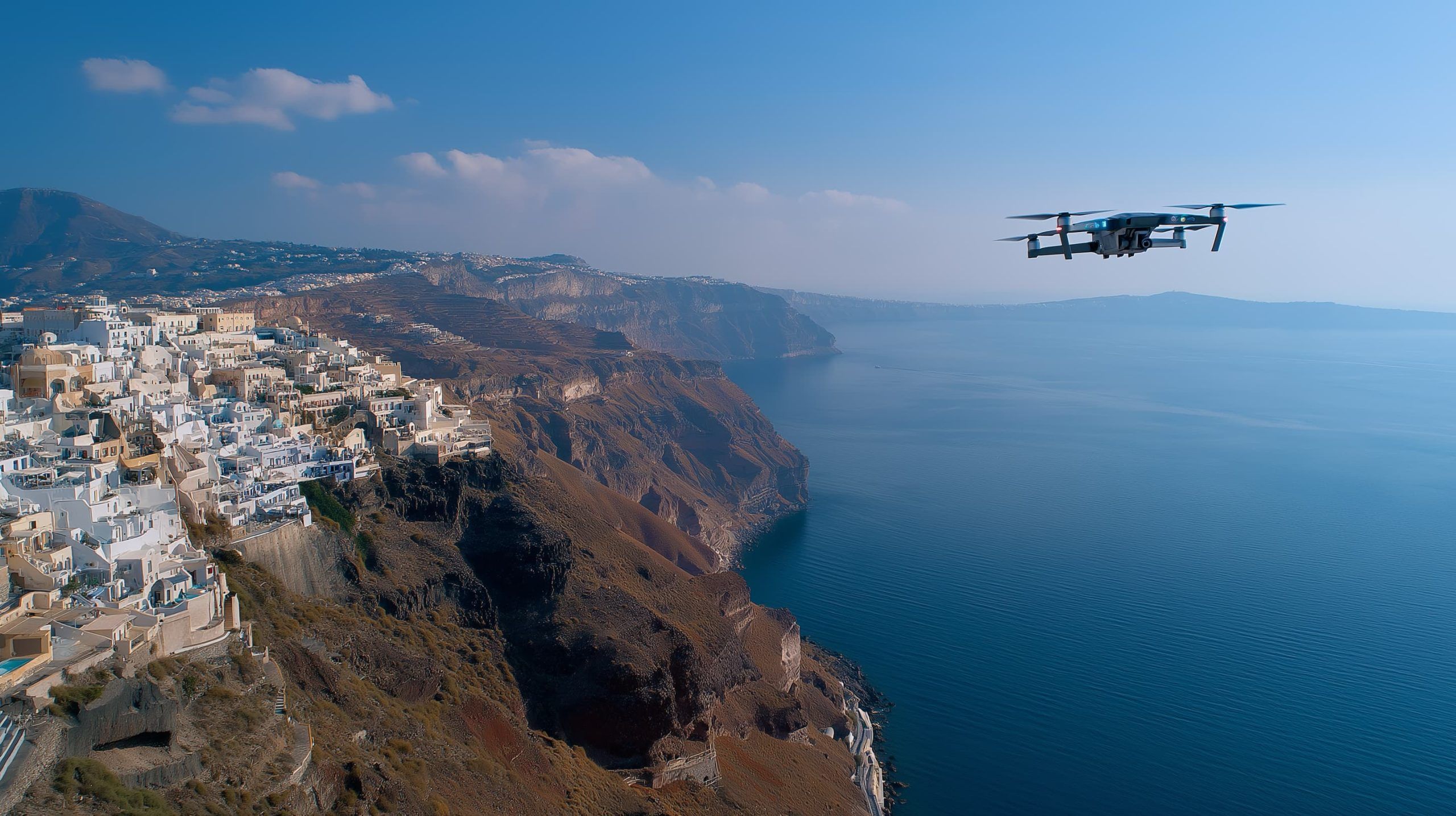- Drones are allowed in Santorini but strictly regulated under Greek and EU rules, with no tourist exception.
- In the Open Category, drones must weigh under 25 kg, fly below 120 m, stay in sight, and use EU class ID 0-4 or a legacy model bought before 2023.
- Registration is required for any drone over 250 g or with a camera, giving the operator a single EU-wide registration number via the HCAA.
- Commercial or advanced operations fall under the Specific or Certified categories and require insurance and HCAA approval for each flight.
- Before flying, you must file a flight application with the HCAA for Santorini, including your operator number, pilot certificate, drone details, insurance if needed, and a detailed flight plan.
- Applications should be submitted at least 3 working days in advance, with 5+ days if near military zones, and approval must be received before flight.
- Major no-fly zones include Santorini’s airport 8 km radius, designated archaeological sites like Akrotiri, and military or critical infrastructure areas.
- Violations carry fines up to €250,000, a minimum around €500 for minor infractions, possible drone seizure, and even criminal charges.
- Since 2021 Greece follows EASA rules, and as of 2024 operators must use EU class IDs and consult the Drone Aware GR map before flights.
- Practical tips include planning ahead, using the Drone Aware Greece map, flying in daylight, keeping a visual line of sight, and carrying proof of approval and registration.
1. Overview – Santorini Drone Regulations (Recreational vs Commercial)
Flying a drone in Santorini is legal but highly regulated. The Hellenic Civil Aviation Authority (HCAA) allows drones on the island, provided pilots follow all Greek and EU rules and obtain necessary approvals in advance [1]. Both recreational hobbyists and commercial operators are subject to these laws – there is no “tourist exception” [2]. In practice, recreational users can fly under the EU Open Category rules (e.g. lightweight drones under 25 kg, under 120 m altitude, always in sight) as long as they stay in approved areas and away from people or sensitive sites [3] [4]. However, even for personal use, Greece requires you to register as a drone operator if your drone weighs over 250 g or has a camera [5] [6]. Commercial use (any flight for business, profit, or specialized tasks like surveying) is more strictly controlled – you must obtain special permission for each operation [7] and carry drone liability insurance [8]. In short, whether you’re a vlogger with a DJI Mini or a professional filmmaker, you need to play by the same core rules. The key differences are that commercial pilots are required to carry insurance and must get HCAA authorization for all flights [9], whereas recreational fliers with small drones have a bit more freedom for low-risk flights in unrestricted areas. But don’t be complacent – even hobby pilots face many rules in Santorini, and breaking them can lead to serious penalties.
2. Greece’s Drone Legal Framework (Registration, Licensing & Insurance)
Santorini falls under Greece’s national drone laws, which since 2021 are harmonized with the EU’s European Union Aviation Safety Agency (EASA) regulations [10]. This means Greece recognizes the EU-wide categories of Open, Specific, and Certified operations. Most tourists will fly in the Open Category, which has strict limits: your drone must have an EU class ID (0 through 4) or be a legacy drone bought before 2023, weigh under 25 kg, stay under 120 m altitude, and not fly over uninvolved people (unless it’s under 250 g) [11] [12]. Registration: Greece requires drone operator registration through the HCAA for any drone over 250 g or any drone with a camera (unless it’s a toy) [13] [14]. This is a one-time registration of you as a pilot, not of the individual drone – once registered, you receive a unique operator number valid across all EU countries [15]. If you’ve already registered in another EASA member state, you don’t need a separate Greek registration, but non-EU visitors must register with HCAA before flying [16] [17]. Licensing: In addition, pilots need to have the appropriate EASA drone certificate for the category they’re flying in. For most recreational drones above 250 g, that means passing the basic online exam (A1/A3 certificate), and possibly an A2 certificate for larger drones flying closer to people. Commercial or advanced operations may fall under the Specific Category, requiring an operational authorization and higher level of training. In Greece, the HCAA treats any non-trivial drone use as something that must be vetted – even a visiting EU-certified pilot must obtain HCAA’s approval to fly in Santorini [18]. Insurance: Greece mandates liability insurance for all commercial drone operations and any higher-risk flights (Specific/Certified categories) [19]. Recreational pilots flying in the Open category are not obligated to have insurance unless their drone is hefty (>4 kg) [20], but it’s strongly recommended to carry insurance anyway. In summary, Greece’s legal framework mirrors EU standards on paper (same weight categories, altitude limits, etc.), but adds extra layers like mandatory flight plan applications and stricter enforcement via the HCAA. Before flying, make sure you have (1) registered as an operator with HCAA or your home EU country, (2) obtained the required pilot license/certificate, and (3) if needed, insured your drone and yourself for liability.
3. No-Fly Zones in Santorini (Airports, Archaeological Sites, and More)
Despite Santorini’s beauty, you cannot fly your drone everywhere. Several areas are designated no-fly or restricted zones for drones, either by law or local rule. Always consult the official Greek drone map (Drone Aware GR) to identify these zones [21] [22]. Below are the key locations to avoid:
- Santorini (Thira) National Airport (JTR): By law, you must stay at least 8 km away from any airport when flying a drone [23]. This effectively puts a large central portion of Santorini off-limits. The island isn’t big – JTR’s 8 km radius covers the capital Fira, the busy village of Imerovigli, and many surrounding areas. Do not attempt to fly near planes or within the airport’s approach path. Even small drones are banned in this airspace for safety. (Note: Some guides mention 1 km, but Greece’s official guidance is a much wider berth around airports [24]. When in doubt, err on the side of more distance.)
- Archaeological and Historical Sites: Greece fiercely protects its cultural heritage. Drone overflights of archaeological sites or monuments are strictly prohibited without special permission [25] [26]. In Santorini, this means you cannot fly over places like the Akrotiri Excavations (the prehistoric city ruins) or the ancient clifftop site of Ancient Thera unless you have explicit written authorization from the Greek Ministry of Culture. Even flying near these sites could be interpreted as a violation. Essentially, any officially designated heritage site is a no-fly zone. (For perspective, flying a drone over the Acropolis in Athens is completely forbidden without a filming permit [27] – Santorini’s ruins are treated similarly seriously.)
- Military and Critical Infrastructure: Santorini hosts a military radar station on Mount Profitis Ilias and possibly other smaller installations. Drone flights over or near military bases, installations, or government facilities are banned [28] [29]. The same goes for critical infrastructure like ports, power stations, and hospitals [30] – these are sensitive areas where drones are not allowed without special clearance. For example, avoid flying around Santorini’s main ferry port (Athinios) or the old port below Fira when cruise ships are present, as these could be considered sensitive maritime infrastructure. Always maintain a wide distance from any police stations, prisons, or military-owned land on the island as well.
- Crowded Tourist Zones (Privacy & Safety): Some areas are not legally off-limits but are practically no-fly zones due to crowds and privacy concerns. The prime example is Oia – the famous village at Santorini’s northern tip known for its packed sunset viewpoint. Local authorities have posted signs in Oia explicitly forbidding drone flying [31]. This is largely to protect the thousands of visitors and the many cliffside hotels from noise, accidents, or unwelcome filming. Even if you somehow find a legal loophole (Oia lies just outside the airport’s 8 km radius), flying over a dense crowd here would violate the rule against flying over uninvolved people (50 m distance rule) and could get you in trouble [32]. Likewise, flying over busy beaches (e.g. Perissa or Kamari in peak season) or over private resorts/villas without permission is prohibited by law and etiquette [33] [34]. Assume that any congested area – whether it’s tourists watching the sunset in Oia, a wedding crowd, or a hotel pool – is a no-go for your drone.
In short, plan your Santorini flights very carefully. The island has limited open spaces for drones because of the airport and many sensitive sites. According to one local photographer, basically the only villages fully outside restricted zones are Oia (north end) and Akrotiri (southwest) [35] – and even in those, you must still avoid flying over people’s homes or the Akrotiri ruin site itself. Always double-check the DAGR map for yellow or magenta zones (which indicate airspace restrictions around airports, helipads, or special sites) and respect all posted signs [36] [37]. If you violate a no-fly zone, you risk immediate intervention by authorities or locals and heavy penalties.
4. Required Permissions and Authorizations
Flying a drone in Santorini is not a spontaneous activity – it requires paperwork and prior authorization from Greek authorities in most cases. Here’s what you need to do before taking off:
- Register as a Drone Operator: Ensure you are registered with an EU aviation authority. If you’re from outside the EASA zone (e.g. the US or another non-EU country), you must register with the HCAA as a drone operator before flying in Greece [38] [39]. This involves an online form (or email to HCAA) to obtain your operator registration number. Plan ahead, as HCAA can take around 3+ working days to process registrations [40].
- Have a Valid Drone Pilot Certificate: Make sure you’ve passed the required exams (for most, the free EU A1/A3 online test, and possibly A2 for larger drones) and have your Remote Pilot Certificate handy. HCAA will ask for proof of your competency or license during the authorization process [41], especially for non-recreational flights.
- Submit a Flight Application to HCAA: For each drone flight or project in Santorini, you are expected to file a request with the HCAA (typically via email or the online Drone Aware GR platform) before you fly [42]. This application includes detailed info: your operator registration number, copies of your pilot certificate, details of your drone (model, weight, serial number), proof of insurance if required, and a detailed flight plan [43] [44]. You’ll need to specify when and where you intend to fly – including maps or GPS coordinates of the exact area, flight path sketches, and alternate dates in case of denial or bad weather [45] [46]. Essentially, you’re asking permission for a specific flight in a specific location.
- Apply Well in Advance: Send your flight request at least 3 working days before you plan to fly [47]. HCAA needs time to review it, and they coordinate with military authorities if your area is near any military zone (in which case they ask for 5+ days notice for extra clearance) [48]. Don’t expect to get next-day approval; plan your drone shots early in your itinerary.
- Await Approval and Fly Only Once Cleared: If everything is in order, HCAA will issue you an approval (or possibly a NOTAM) for your flight. Do not fly until you have this official OK. Once approved, you are also required to notify the local police in Santorini of your flight plans [49] – basically to double-check that authorities on the ground know you have permission. Carry your approval email/document and registration info when you go out to fly, in case police or authorities ask for it.
- Obtain Special Permissions if Needed: If your planned flight involves any “sensitive structures” or locations (for example, flying near an archaeological site, over a historic church, or in a national park area), you must also get written consent from the responsible authority and include it in your application [50]. For instance, to film over the Akrotiri ruins you’d need permission from the Ephorate of Antiquities (Ministry of Culture), or to fly over private property like a winery or hotel you’d need the owner’s written okay. Without those, HCAA will not approve that part of your flight. Always ask yourself if the location might be sensitive or private – and if so, seek permission from the owner/authority well ahead of time.
These steps might seem cumbersome, but Greece treats drone flights almost like mini flight plans. Each flight should be documented and authorized. In fact, the official guidance explicitly says an application is required for each individual drone flight [51]. Skipping this process is risky – flying “under the radar” without a permit might work in extremely isolated spots, but if you’re caught, the excuses will not help you. It’s worth noting that for very small drones (<250 g) performing low-risk flights within 50 m of the pilot, some hobbyists have flown without going through full approval [52] [53] – but this is technically only allowed if you remain within that 50 m limit and outside restricted zones. To be safe (and fully legal), follow the procedures: register, apply, and wait for permission. Santorini’s authorities are used to tourists requesting drone permits, so while it’s bureaucratic, it’s relatively straightforward if you submit all required info.
5. Penalties for Violating Drone Laws
Think twice before breaking the drone rules in Santorini – the penalties are severe. Greece has implemented heavy fines and sanctions to deter irresponsible drone use. If you fly without the proper approvals or break the no-fly zone rules, you can face a minimum fine of around €500 for a minor infraction [54]. More serious violations (for example, endangering aircraft near the airport, crashing a drone into a protected site, or repeated offenses) carry astronomical fines up to €250,000 [55]. Yes, that is a quarter of a million euros – a number confirmed by HCAA’s published range of penalties. These fines are not theoretical; other European countries have issued five-figure and even six-figure fines to drone hobbyists who flew recklessly in restricted areas. In Greece, a British tourist made headlines for facing a €200,000+ fine after flying illegally during a crowded event abroad [56], illustrating how costly drone misconduct can be.
Besides financial penalties, authorities can also confiscate your drone equipment if you violate the law [57]. Your drone could be impounded on the spot by police if you’re caught flying where you shouldn’t. In extreme cases (like interfering with airport operations or causing an accident), criminal charges could be brought, which might involve court appearances or even imprisonment under aviation safety laws. At the very least, an offender will be grounded and possibly escorted off the site by police. Bottom line: the cost of ignoring the rules is far greater than the effort to comply. A ruined vacation, a seized drone, and a massive fine is a very real risk if you fly irresponsibly in Santorini. Always err on the side of caution and follow the regulations – your wallet will thank you.
6. Recent Changes & Enforcement Updates
Drone regulations have evolved in recent years, so it’s important to stay updated. In January 2021, Greece (like all EU countries) adopted the new unified EASA drone rules, replacing older national categories [58]. This change brought standardization – for example, the 120 m max altitude, 250 g registration threshold, and the A1/A2/A3 subcategory system now apply in Santorini just as in Paris or Rome. However, Greece also kept some of its stricter local requirements. Notably, the long-standing rule that you must file a flight plan for each flight is still in force [59], which surprises some foreign pilots used to more open systems. So don’t assume that just because you could fly freely in, say, Germany or Croatia within the Open category, you can do the same in Greece – you still need to go through HCAA’s approval process here.
On the enforcement side, Greek authorities have become more vigilant about drones, especially in tourist hotspots. In the past couple of years, Santorini’s local officials and businesses have voiced concerns about drone noise, safety, and privacy. As a result, by 2023 we saw measures like the “No Drone Flying” signs in Oia to dissuade operators [60]. Police and even hotel staff in popular areas are more alert now and may intervene if they see unauthorized drones. There have been reports of drones being spotted and the operators questioned, especially if flying near crowds or sensitive sites. While Greece welcomes responsible drone use (the HCAA even launched the Drone Aware GR platform to help pilots plan flights [61]), there is a clear push to clamp down on rule-breakers who might risk accidents or disturb others. Summer 2022 and 2023 saw increased drone monitoring during peak tourist season – for instance, extra checks around the Acropolis in Athens and likely on islands like Santorini where big crowds gather.
In terms of regulatory tweaks, one notable change was the introduction of the Drone Aware GR online map and flight request system in recent years. It’s now mandatory to consult this map before any flight and use it when submitting your area coordinates for approval [62] [63]. The HCAA has been updating its online guidance (including an English “Information for visitors” page) to reflect EASA rules and the application procedure, indicating an effort to educate foreign pilots [64]. Additionally, as of 2024, all drone operators in Greece must have transitioned fully to the EASA system – meaning if you bought a drone before 2023 with no class mark, you can only fly it in limited subcategories now, and new drones must have EU class identification for certain operations. The EU is also moving towards requiring remote ID broadcasts on drones, and Greece will likely enforce those requirements in step with EU deadlines (keep an eye on updates around 2024–2025 for remote ID rules).
The key takeaway is that Santorini (and Greece in general) is getting stricter about drones, not more lenient. The rules you might have read in 2019 or 2020 have been augmented by EU-wide laws and reinforced by local enforcement. Always double-check the latest HCAA notices before flying – and when on the island, observe what local signs or guidelines say. The fact that even a small village like Oia has drone prohibition signs now shows how enforcement has become a local priority. By 2025, the combination of EU regulations and proactive local measures means responsible pilots need to be more prepared than ever – but if you follow the rules, you can still enjoy stunning aerial views of Santorini without trouble.
7. Santorini vs Other Destinations – How Do the Rules Compare?
Wondering if Santorini’s drone rules are unusually harsh or just business as usual? Let’s compare: Within Greece, all tourist destinations are under the same national drone law, but the on-the-ground reality can differ. For example, flying in Athens is even more restrictive – the city is dense, full of archaeological treasures, and has multiple airports nearby. Drones are virtually banned over central Athens without special permits. You absolutely cannot fly over the Acropolis or any ancient monument there unless you have a rare filming permit from the Ministry of Culture [65]. In fact, recreational drone flights are seldom allowed in central Athens at all due to the urban environment; authorities require HCAA approval and often municipal permission for any drone activity in the city [66]. Compared to that, Santorini’s villages (outside the airport zone) are more open—there’s no blanket ban on drones island-wide, and many people do capture aerial footage, but it’s “monitored closely” by authorities and locals [67]. Popular islands like Mykonos or Rhodes similarly follow the HCAA rules: you must stay away from airports (each island with an airport has a large no-fly radius) and avoid crowded beaches or heritage sites. Mykonos, for instance, has an airport near town, so large parts of the main tourist areas fall under restricted airspace just like in Santorini. Crete is larger, giving more open space to fly in rural areas, but around its cities and airports (Heraklion, Chania) the same 8 km rule and site-specific restrictions apply. One common thread: anywhere in Greece with significant ancient ruins or UNESCO sites (Olympia, Delphi, Meteora’s monasteries, etc.) will have those areas off-limits to drones without permission – Santorini is no exception in that regard.
Comparing Santorini’s rules to other EU tourist hotspots, the safety rules are largely the same thanks to EU harmonization, but Greece’s enforcement is stricter. All EU countries enforce the basics: 120 m max height, no flying over uninvolved people, no drones in controlled airport airspace without clearance, and so on [68] [69]. So if you’ve flown in Spain, France, or Italy, you’ll find the general technical limits familiar. For example, no country in the EU will let you fly over crowds or near an active runway. However, the requirement to apply for every flight is somewhat unique to Greece [70]. Many EU countries allow hobbyists to operate in the Open category without prior notice as long as they stay in allowed areas. In Greece (and thus Santorini), you technically need to submit that flight plan email each time, which can feel bureaucratic to foreign pilots. Enforcement also differs: some countries have few officers checking on hobby drones, whereas in Santorini the combination of local complaints and the island’s small size means you’re more likely to be noticed if you break the rules.
It’s also instructive to compare fines: Greece’s maximum fines (up to €250k) are among the highest in Europe [71], signaling how serious they are. Other countries like Italy or the UK have similarly high theoretical fines for endangering aircraft, but for typical tourist infractions (like flying over a crowd or in a park without permission), fines in the few hundred to few thousand euro range are more common in practice. Still, Santorini’s authorities won’t hesitate to hit you with a hefty fine or seize your drone; they’ve done so to protect archaeological sites and privacy. One positive comparison: Greece’s drone registration is part of the EU system, so once you register (say, in Santorini), that registration is valid if you go drone flying in other EU countries later [72]. And your EASA pilot certificate from home is valid in Greece too.
To sum up, Santorini’s drone laws align with EU standards on paper, but the island’s characteristics (airport proximity, many historic sites, and heavy tourism) lead to tighter practical restrictions. If you’ve flown in less crowded EU destinations, Santorini will feel stricter. On the other hand, if you attempt in Italy to fly over the Colosseum or in Paris near Notre Dame, you’d face similar pushback as flying over Santorini’s caldera villages – it’s universally frowned upon to buzz famous landmarks without permission. Always research local nuances: in Zakynthos (another Greek island hotspot), for instance, drones are allowed but pilots were fined for disturbing endangered turtle nesting areas on beaches [73], a reminder that wildlife protection is another concern. Every destination has its quirks; Santorini’s happen to be an airport in the middle and postcard-perfect villages where peace and privacy are valued. Abide by the Greek rules and you’ll find it comparable to other places – break them, and you’ll find Greek penalties can be among the toughest.
8. Tips for Safe and Legal Drone Flying in Santorini
To make sure you enjoy flying your drone in Santorini without any run-ins with the law or angry locals, follow these tips:
- Plan Ahead and Get Approval: Spontaneous drone flights are not viable in Santorini. Always plan your flights days in advance and submit the required HCAA application before you arrive [74]. Keep copies of your approval email and registration with you when flying.
- Use the Official Drone Map: Before takeoff, check the DAGR Drone Aware Greece map for your exact location [75]. This interactive map will show if you’re in a restricted (yellow/magenta) zone or near any temporary restrictions. It’s a must-have tool – consider using the mobile app or website to get real-time updates on no-fly zones [76].
- Choose Your Flying Location/Time Wisely: Opt to fly in less crowded areas and times. For example, an early morning flight over a quiet beach or field is far safer (and more legal) than a sunset flight over Oia packed with tourists. Avoid peak tourist spots during busy hours – if a location is crowded on the ground, it’s not suitable for your drone [77]. Also, stay well away from houses, hotels, and people unless you have permission – Santorini’s boutique hotels value privacy, and a drone buzzing their infinity pool can cause complaints.
- Respect Altitude and Distance Limits: Always keep your drone below 120 m (400 ft) above ground level [78] – this is both an EU and Greek limit. Maintain a safe horizontal distance from people, structures, and especially the airport (8+ km as discussed). If you’re flying without a special permit (e.g. just a quick personal flight), remember the Greek unregistered limit: stay within 50 m of yourself [79]. And of course, keep your drone within visual line of sight at all times [80]; losing sight of it is not only unsafe but also illegal.
- Fly Only in Daylight and Good Weather: In Greece you cannot fly at night – legally, flights are only allowed from 30 minutes before sunrise until 30 minutes after sunset [81]. Plan to fly in daylight hours with clear weather. Santorini can get very windy, especially along the caldera cliffs; avoid flying in strong winds or poor visibility. If conditions turn bad, land immediately. Good weather not only keeps you legal (required for VFR conditions) [82] but also protects your drone from accidents.
- Be Mindful of Privacy and Etiquette: When flying near inhabited areas, respect people’s privacy. Do not film private homes, hotel balconies, or sunbathers on a beach without permission. Greek privacy laws can come into play if you harass or spy on individuals with your drone. It’s both polite and legally smart to avoid hovering over private property [83]. If someone approaches you with concerns, be courteous – often a polite explanation or relocating your flight can diffuse tensions with locals.
- Carry Insurance and Fly Responsibly: While hobby flyers with small drones aren’t forced by law to have insurance, it’s wise to have coverage. Santorini’s terrain (cliffs, buildings, water) is unforgiving if something goes wrong. Drone liability insurance will protect you if your drone accidentally causes damage or injury. Even beyond insurance, fly defensively – don’t attempt risky maneuvers over people or property, and have a return-to-home plan if signal is lost. The goal is to capture Santorini’s beauty safely.
- Follow All HCAA/EASA Rules: This might sound obvious, but it bears repeating: stick to the basics. No dropping objects from the drone, no carrying dangerous goods, and no flying when under the influence of alcohol. Have your drone’s registration number affixed to it as required [84]. In essence, operate as if a regulator or experienced pilot is watching over your shoulder. If you abide by the official rules and use common sense, you’ll stay out of trouble.
By following these tips and the regulations outlined above, you can legally enjoy breathtaking aerial views of Santorini’s caldera, whitewashed villages, and beaches. Many travelers do successfully fly drones in Santorini each year – the key is that they do their homework first and exercise caution at all times. Fly safe, respect the island’s rules and people, and you’ll come home with amazing footage and your drone intact. Happy flying! [85]
Sources: Santorini & Greece Drone Regulations – HCAA guidelines [86] [87]; Drone law articles and travel blogs [88] [89] [90]; EU EASA Drone Rules [91] [92]; Santorini local insights [93] [94].
References
1. www.droneblog.com, 2. www.flyingglass.com.au, 3. uavcoach.com, 4. www.flyingglass.com.au, 5. www.flyingglass.com.au, 6. www.flyingglass.com.au, 7. twogetlost.com, 8. uavcoach.com, 9. uavcoach.com, 10. www.droneblog.com, 11. uavcoach.com, 12. uavcoach.com, 13. www.flyingglass.com.au, 14. www.flyingglass.com.au, 15. www.flyingglass.com.au, 16. www.droneblog.com, 17. www.droneblog.com, 18. www.droneblog.com, 19. uavcoach.com, 20. uavcoach.com, 21. hcaa.gov.gr, 22. hcaa.gov.gr, 23. santorinivacationphotography.com, 24. santorinivacationphotography.com, 25. www.flyingglass.com.au, 26. uavcoach.com, 27. www.flyingglass.com.au, 28. www.droneblog.com, 29. hcaa.gov.gr, 30. hcaa.gov.gr, 31. dutchtraveller.nl, 32. www.flyingglass.com.au, 33. uavcoach.com, 34. www.droneblog.com, 35. santorinivacationphotography.com, 36. hcaa.gov.gr, 37. dutchtraveller.nl, 38. www.droneblog.com, 39. www.droneblog.com, 40. www.droneblog.com, 41. www.droneblog.com, 42. uavcoach.com, 43. www.droneblog.com, 44. www.droneblog.com, 45. www.droneblog.com, 46. www.droneblog.com, 47. uavcoach.com, 48. uavcoach.com, 49. santorinivacationphotography.com, 50. uavcoach.com, 51. uavcoach.com, 52. santorinivacationphotography.com, 53. www.reddit.com, 54. www.droneblog.com, 55. www.droneblog.com, 56. dronedj.com, 57. www.smartraveller.gov.au, 58. www.droneblog.com, 59. twogetlost.com, 60. dutchtraveller.nl, 61. hcaa.gov.gr, 62. hcaa.gov.gr, 63. uavcoach.com, 64. www.smartraveller.gov.au, 65. www.flyingglass.com.au, 66. www.flyingglass.com.au, 67. www.flyingglass.com.au, 68. uavcoach.com, 69. uavcoach.com, 70. uavcoach.com, 71. www.droneblog.com, 72. www.flyingglass.com.au, 73. www.flyingglass.com.au, 74. twogetlost.com, 75. hcaa.gov.gr, 76. www.droneblog.com, 77. www.flyingglass.com.au, 78. uavcoach.com, 79. santorinivacationphotography.com, 80. www.droneblog.com, 81. santorinivacationphotography.com, 82. twogetlost.com, 83. uavcoach.com, 84. www.droneblog.com, 85. www.droneblog.com, 86. hcaa.gov.gr, 87. uavcoach.com, 88. www.droneblog.com, 89. www.flyingglass.com.au, 90. dutchtraveller.nl, 91. uavcoach.com, 92. uavcoach.com, 93. santorinivacationphotography.com, 94. www.flyingglass.com.au










